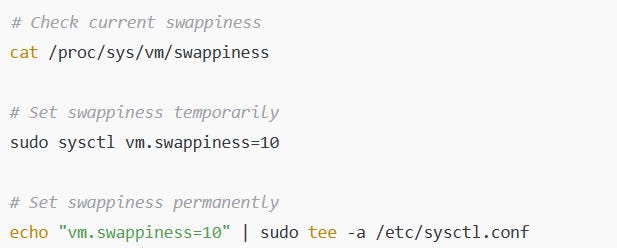Swapping in Linux: Extending Memory with Disk Space
Swapping is a vital mechanism in Linux memory management that helps the system handle memory pressure when physical RAM is insufficient. It involves moving inactive memory pages from RAM to a designated swap space on a storage device, allowing active processes to continue functioning smoothly. In this blog, we’ll explore the concept of swapping, its benefits and drawbacks, and how to monitor and manage it effectively.
What is Swapping?
Swapping refers to the process of moving inactive pages of memory from RAM to swap space, freeing up RAM for active processes. Swap space is typically a portion of a disk (e.g., a swap partition or swap file) reserved for this purpose.
Why is Swapping Needed?
Memory Overcommitment:
When the combined memory requirements of all running processes exceed the available physical RAM, swapping allows the system to handle the excess.
Avoiding Out-of-Memory (OOM) Errors:
Without swapping, the kernel would need to terminate processes when memory is exhausted.
Supporting Large Workloads:
Swapping helps the system accommodate workloads that require more memory than is physically available.
How Swapping Works
Step 1: Identifying Pages to Swap
The kernel selects inactive pages (pages not recently accessed) to move to swap space.
This selection is based on algorithms like Least Recently Used (LRU) to minimize performance impact.
Step 2: Writing Pages to Swap
The selected pages are compressed (if supported) and written to the swap space.
The corresponding physical RAM is freed up for active pages.
Step 3: Retrieving Pages from Swap
When a swapped-out page is accessed, the kernel retrieves it from swap space and moves it back to RAM.
If RAM is full, another inactive page is swapped out to make room.
Benefits of Swapping
Memory Extension:
Swap acts as an extension of physical RAM, allowing the system to run larger workloads.
Improved Stability:
Prevents OOM errors by ensuring the system can handle memory exhaustion gracefully.
Enhanced Multitasking:
Enables more processes to run concurrently by offloading inactive pages.
Drawbacks of Swapping
Performance Penalty:
Disks are significantly slower than RAM, so accessing swapped-out pages can degrade performance.
Increased Latency:
Frequent swapping (also called thrashing) can cause noticeable delays as the system spends more time moving pages between RAM and disk.
Wear and Tear:
On SSDs, excessive swapping can reduce the lifespan of the drive due to write cycles.
Swap Space Types
Swap Partition:
A dedicated partition on a disk reserved for swapping.
Example:
/dev/sda2.
Swap File:
A regular file on the filesystem that serves as swap space.
Easier to resize and manage compared to partitions.
Monitoring and Managing Swap
Commands to Monitor Swap
Adjusting Swap Behavior
Swappiness:
Controls how aggressively the kernel uses swap space.
Value ranges from
0(minimize swapping) to100(maximize swapping).
Adding Swap Space:
Create a Swap File:
Make it Persistent: Add the following line to
/etc/fstab:
Removing Swap Space:
Disable the swap file:
Tips for Effective Swap Management
For Developers:
Optimize Memory Usage:
Avoid excessive memory consumption to minimize swapping.
Handle Latency Gracefully:
Design applications to tolerate delays caused by swapping.
For System Administrators:
Monitor Swap Usage:
Use tools like
htoporfreeto detect heavy swapping.
Optimize Swappiness:
Adjust swappiness based on workload requirements (e.g., databases may prefer minimal swapping).
Use SSDs for Swap:
If possible, place swap space on SSDs for faster access.
Conclusion
Swapping is a critical feature of Linux memory management that extends the system’s memory capabilities beyond physical RAM. While it provides stability and flexibility, it comes with trade-offs in performance. By understanding how swapping works and monitoring its usage, you can ensure that your system remains responsive and efficient under memory pressure.









